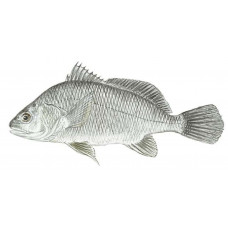Latin name
Aplodinotus grunniens
Other names
Sheepshead, croaker, grunt, drum, silver bass, thunder pumper; French: malachigan.
Identification
The body is deep, with a crooked back, a blunt snout and a subterranean mouth adapted for bottom feeding. The pharynx contains a set of powerful teeth. It has two dorsal fins, the first of which has eight to nine spines. The anal fin has two spines, the second of which is long and extremely thick. The caudal fin is bluntly pointed. The colouration on the back is green to grey with silvery patches and a white belly. The large silvery scales are rough to the touch. Its two dorsal fins and rounded tail distinguish it from carp and buffalo. In addition, the first dorsal fin of the freshwater drum has eight to nine spines, while the carp has only one spine at the beginning of its single dorsal fin with soft rays, and the buffalo has no spines at all. The freshwater drum can be distinguished from all other freshwater fishes by its lateral line, which extends to the tip of the tail and is characteristic of sciennids.
Distribution
The freshwater drum is found throughout most of the United States, between the Rocky Mountains and Appalachia, south through eastern Mexico to the Río Usumasinta system in Guatemala, and north through Manitoba, Canada, to Hudson Bay. It is also found in parts of Ontario, Quebec and Saskatchewan.
Habitat
Although it prefers clear water, the freshwater drum is adaptable and can tolerate turbid water better than many other species. It is usually found in large lakes and deep river basins. It prefers deep water, staying on the bottom but moving towards the shore at dusk. Drums are rarely found in small streams or lakes.
Size
The average size of a freshwater drum is 15 inches and 3 pounds, although they can grow to 50 pounds. The average commercial catch is usually between 1 and 5lb. The record for all tackle is 54lb 8oz. Freshwater drum can live up to 20 years.
Life history and Behavior
Freshwater drum spawn in spring when the water temperature reaches 65-70°F. Eggs are released on shallow gravel and sandy areas near the shore. They attach to pebbles or stones on the bottom and hatch within 2 weeks. Neither eggs nor young receive parental care.
Food and feeding habits
Juveniles feed on small crustaceans. Adults eat molluscs, insects and fish. They use their snout to slowly move small rocks and other bottom material in search of food. Their pharyngeal teeth crush the shells of snails or clams, they spit out shells and swallow soft bodies.
Reproduction
No information
| Classification | |
| Phylum | Chordata |
| Class | Actinopterygii |
| Squad | Acanthuriformes |
| Family | Sciaenidae |
| Genus | Aplodinotus |
| Species | A. grunniens |
| Features | |
| Conservation status | Least Concern |
| Habitat | Bottom |
| Life span, years | 72 |
| Maximum body weight, kg | 24.7 |
| Maximum length, cm | 76 |
| Sailing speed, m/s | No information |
| Threat to people | No information |
| Way of eating | Bentophage |
Drum, Freshwater
Tags: Drum, Freshwater


